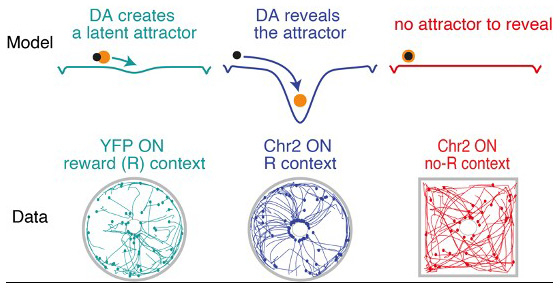Follow us on Google News (click on ☆)
Learning and motivation, the dual role of dopamine
Imagine climbing an apple tree for the first time, either by chance or out of curiosity, and finding a delicious apple. Your brain then associates the action of climbing with a reward, the apple. Dopamine plays a crucial role in this learning process by signaling the reward obtained, which helps form habits.

However, even after learning this association, you won't systematically climb the apple tree. This action will only occur if you are sufficiently motivated, for example by hunger, the desire to play, or to show off your discovery.
Latent attractors: a hidden mechanism in our brain
In a paper published in Nature Communications, scientists propose a new theory about dopamine, based on the concept of latent attractors.
In this theory, dopamine does not merely signal a reward to reinforce a behavior. It also plays a role in activating "latent attractors." These attractors are like "hidden plans" in the brain, ready to be used when the conditions are right (for example, hunger or curiosity).
In other words, these latent attractors represent stable states in the brain, linked to past experiences that have been rewarded. Dopamine acts as a trigger, turning these latent attractors into effective attractors, which activate behavior and guide our actions toward the goal (for example, climbing the tree to get an apple).
From learning to action, dopamine reveals our hidden learnings
To confirm this theory, researchers used a technique called optogenetics, which allows controlling neuron activity using light. By artificially stimulating dopamine neurons in mice, scientists showed that dopamine could "awaken" hidden learnings.
In an environment where mice had learned that a specific location was associated with a reward, dopamine stimulation drew them directly to that spot, even if they were far away. Conversely, in an environment where no location was associated with a reward, the stimulation had no effect, confirming the absence of latent attractors.

Top - Diagram of the dynamics of attractors in the model. The orange dot is the animal's goal, moving in a potential energy landscape where the minimum (attractor) helps determine the goal's position in the environment. The black dot is the animal's behavior, following its goal. The reinforcing effect of dopamine is to build a latent attractor, and its motivational effect is to reveal it.
Bottom - Experimental test of the theory. Optogenetic stimulation of dopaminergic neurons increases the animals' tendency to visit a previously rewarded central point (blue) but has no motor effect in a context without reward (red).
© Jérémie Naudé, Philippe Faure, Bruno Delord.
This study shows that dopamine's function is not only to reinforce habits. It also enables the activation of memories of past experiences, depending on our motivation and the opportunities present.
These "latent attractors" form numerous neural plans ready to be used as soon as the internal state (motivation) and the environment allow it. By shedding light on this mechanism, this discovery opens new perspectives for understanding how the brain transitions from knowledge to action and could have implications in the fields of motivation, learning, and disorders related to the dopaminergic system, such as depression or addiction.
Reference:
Naudé, J., Sarazin, M.X.B., Mondoloni, S. et al. Dopamine builds and reveals reward-associated latent behavioral attractors.
Nat Commun 15, 9825 (2024).
https://doi.org/10.1038/s41467-024-53976-x